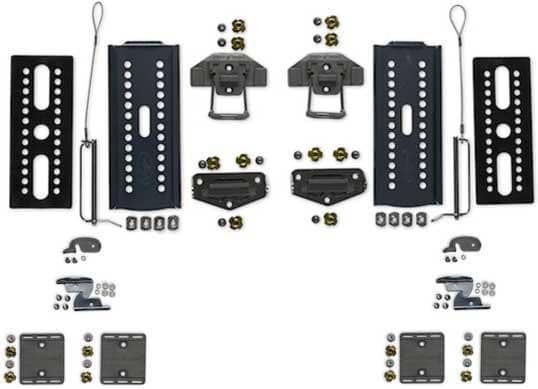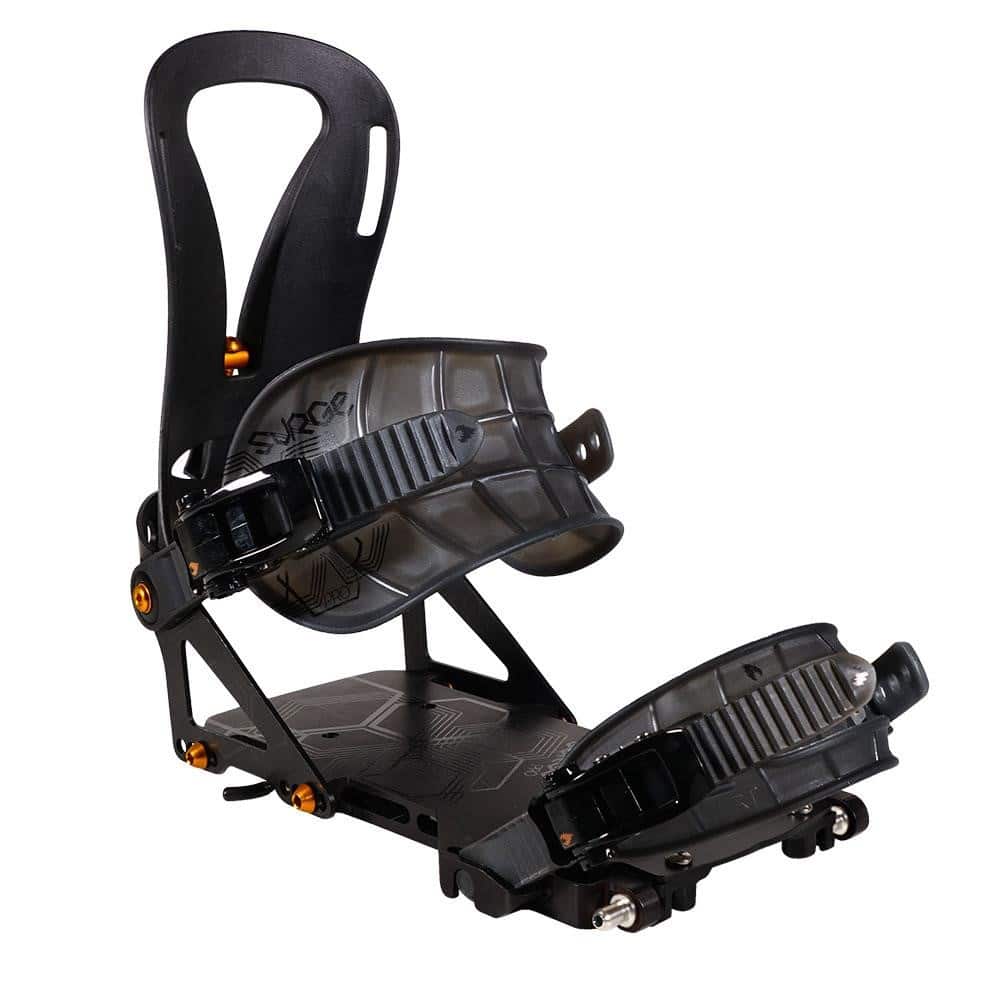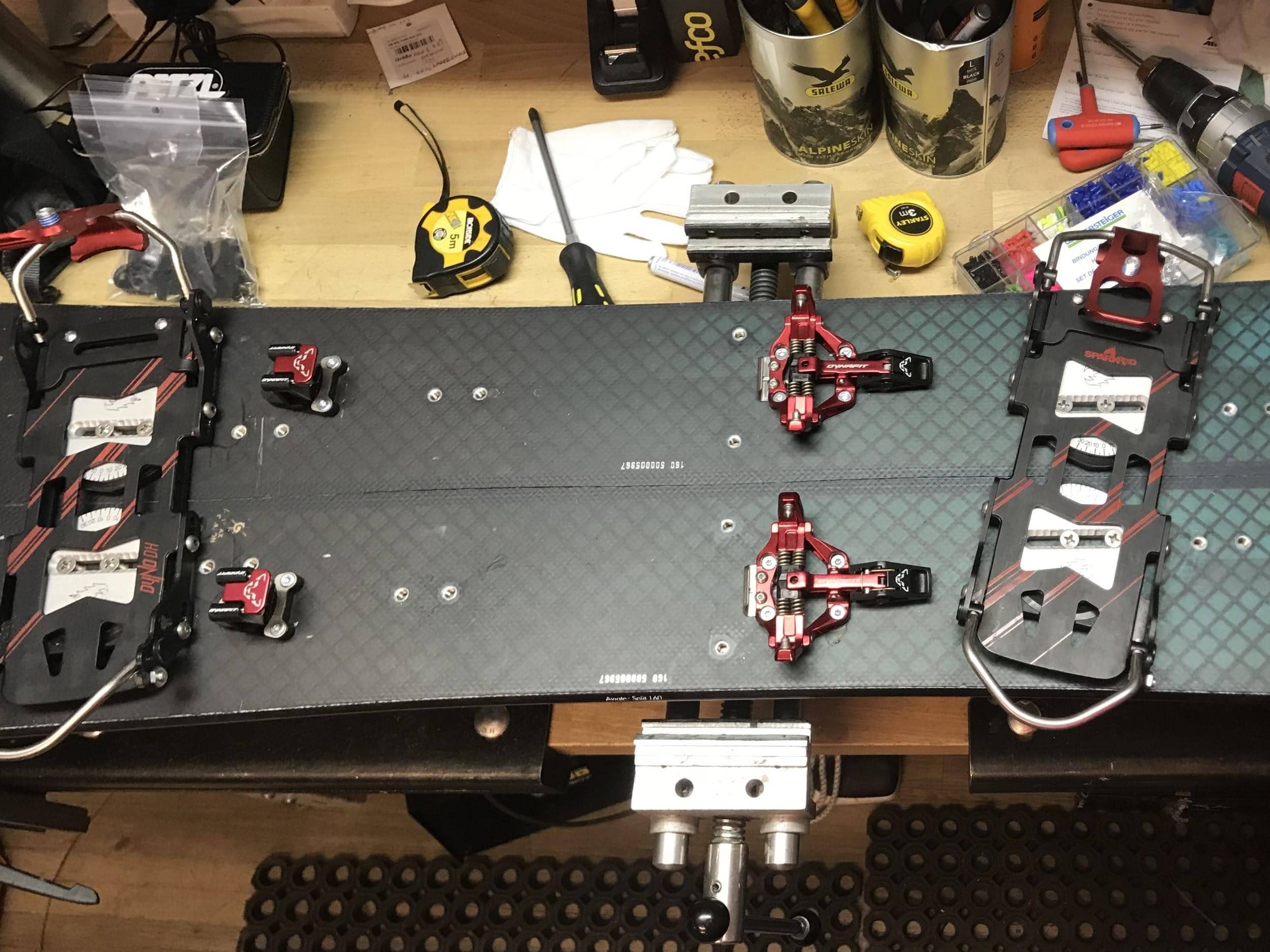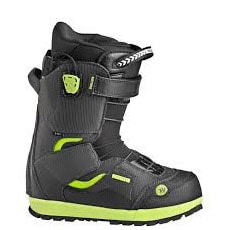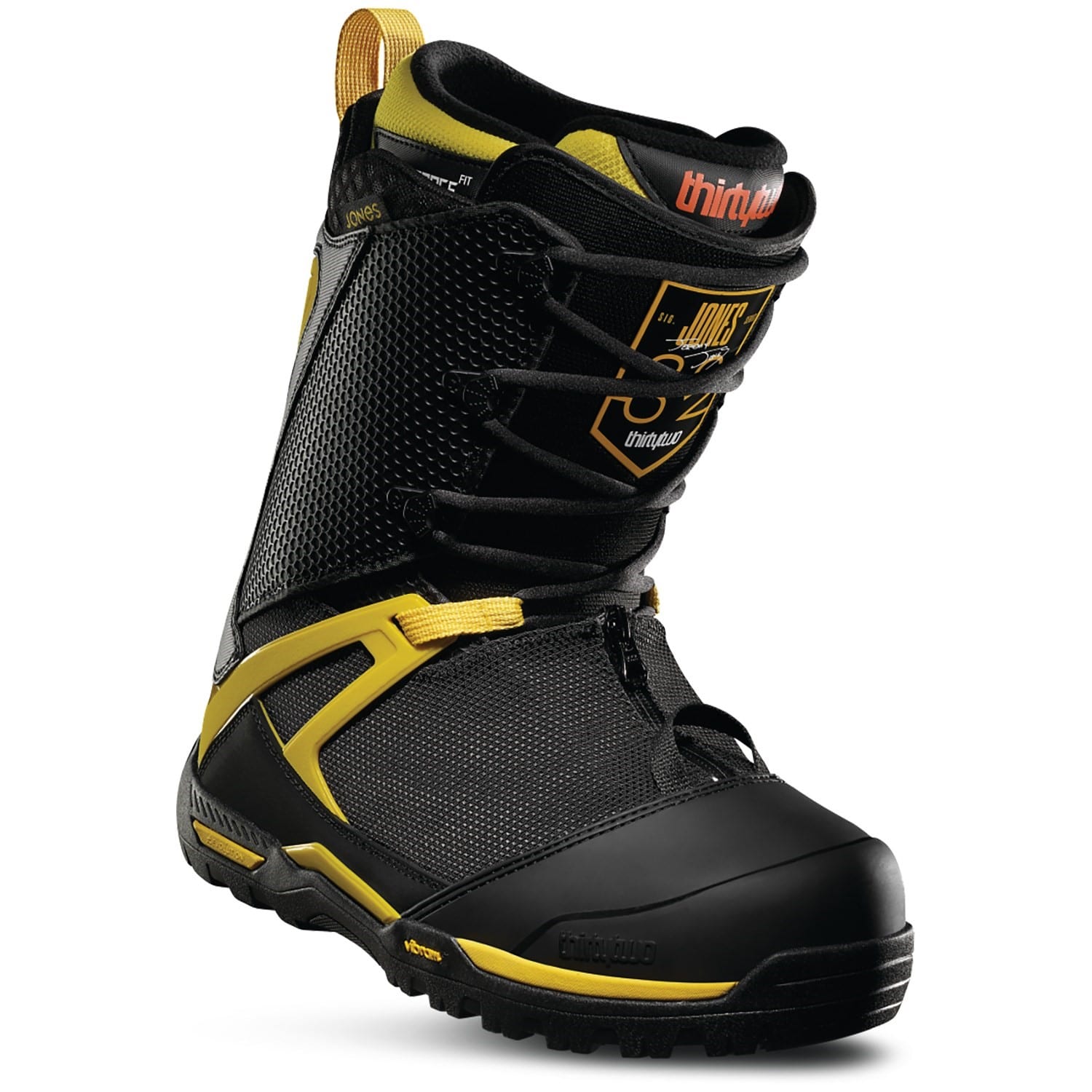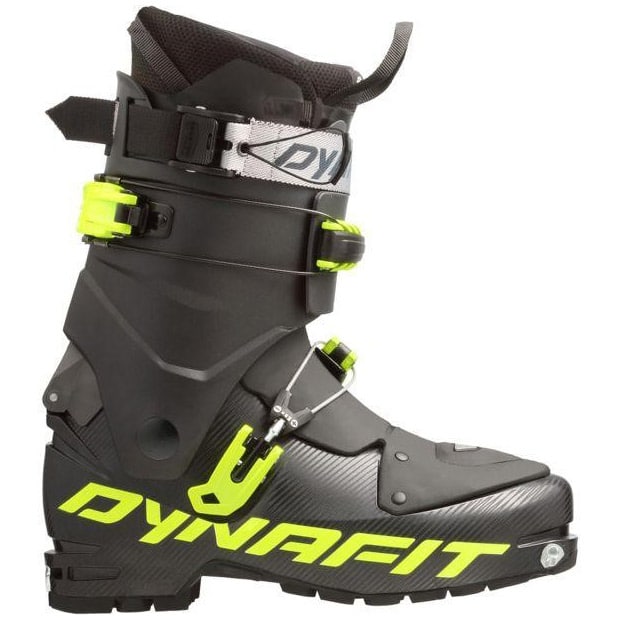I started Splitboarding in 2007 and went touring every winter since then.
This said, I’m no expert in the matter and there are plenty of people out there with a lot more vertical under their skins:)
During the last few years I had the chance to test many different kinds of gear, thanks to a combination of favorable prices and my addiction to snowboarding.
This is a personal opinion and experience, the bindings or the board I love might be the one you hate or vice versa.
Here are some thoughts and Feedbacks on the splitboard gear I used since 2007.
BINDINGS
I was riding the second version of the Karakoram for 4 seasons.
I also tested the carbon prime model from 16/17 for 5 tours.
All together the binding is good but there were a lot of things that often got me thinking that it could be done better.
Pros:
- High back is stiff and well shaped
- Ankle straps are nice and Comfy
- System works great on the slopes
- Nice warranty policy
Cons:
- Price (totally overpriced)
- Design: Many small parts that like to freeze up on your board and make the switches long and uncomfortable.
- Base plate is somehow not giving a great response on the board, it feels thin and not supportive.
- Loads of screws that need to be tightened and regularly checked.
- Parts failing, even though they get replaced, between me and my friends we have seen quite a few key parts braking.
This was my first binding solution for splitboarding.
It’s ok to start with if your on a small budget but it quickly feels bulky and impractical.
Pros:
- Cheap, you can find this adaptor plates at very convenient prices
- Versatility, you can use them with almost any binding
Cons:
- It’s super heavy unless you screw a mad lightweight carbon binding on them
- Change overs are not practical, fiddling with that pin drove me nuts in windy and snowy conditions.
- Your standing very high on walk mode so it’s not efficient at all to walk with.
My friend kept telling me how good the spark binding was so I knew I needed to try the one day.
When I tried the Surge I was really impressed with how well it rides.
They felt so much more like a normal snowboard binding and everything worked easier than in my Karakorams.
The only thing that really did not work was the heel lock which in my opinion it was a design flaw. They now have a new system which I haven’t tried it but it can only be better.
Pros:
- Comfort, you almost forget your riding a splitboard binding.
- Easy to use, nothing freezes up and the changeovers become a lot more pleasant and quick.
- Price, the price is fair and they are the best value for money I have tried on the market.
- Simply and well designed product
Cons:
- Heel lock up to 2017 is not reliable.
The build is solid with few screws and enough adjustment to fit it to almost any touring boot.
Pros:
- Solid construction
- Nice price
- Easy and quick changeovers
Cons:
- When you carry your snowboard around they don’t feel so nice around your arm
Soft versus Hard
Intro:
I always snowboarded in soft boots and the thought of trying hard ones never even crossed my mind but after struggling on so many tours and wasting so much energy I thought there must be a better solution.
Honestly I was also tired of looking like a penguin trying to climb up an icy slope..:)
While researching the web I kept coming across numerous articles about the advantages of using Hard Boots for touring.
Once I heard my friend Michi and great rider was really happy with his new TLT 6 boot i was like…fuck it , i need to put my style ego and preconceptions away and give it a try.
Since I work in a Dynafit shop the changeover was quick and affordable.
Impressions:
When I first tried the TLT6 I expected the walking to be better anyway. I must say it was actually quite fun to ride HB for the first time.
You can put more pressure on your edges with less effort so suddenly your heel edge grips like never before.
Still not the boots you would like to ride all day long or take to the park:)
But for a few carves they felt much better than expected.
The walking is so much better that after the first tour I was 100% sure there was no going back to a soft set up.
Conclusions:
Snowboard boots and bindings are somehow more comfortable and suited for steezy grabs but they are not designed for walking uphill. No matter how many modifications the industry throws at them, they will also never be great at it.
They say 1kg on your feet is like 4 kg on your backpack.
I always liked lightweight things, and once you start going on longer tours and planing 4000m peaks weight will definitely make the difference.
So if I’m spending 90% of the time walking up and I have two choices.
I can go to the top efficiently with a good pace and still feel fresh to enjoy the ride down on slightly stiffer boots.
Or I can drag up 4 or 5 kilos on my feet, feeling totally wasted after 1500 vertical while swearing and wasting more energy every time i need to traverse on harder snow. Just so I can enjoy my soft boots for 10 min on the way down.
For me the answer is obvious, also due to the alpine terrain where I live.
If your doing shorter tours on powder only conditions a soft setup probably works fine.
Pros:
- lightweight : The bindings are 400 gr lighter and if you consider that they are in your backpack while touring up, then you’ve got almost 1 kg less on your feet.
- walk mode, it’s so much nicer to skin up on a boot that has a range of motion like the TLT6, every step feels more natural.
- Efficiency, the pin connection from the Low tech binding makes every step a lot more efficient saving energy for the way down. Dynafit has been making and improving touring bindings for over 30 years.
- Traversing: your inner edge on your lower ski actually grips now, instead of sliding away like it does on a soft setup (Such a waste of energy while touring)
- Heel Lock: if you mount the the heel piece of the Low tech binding on your board you will get a pretty sweet heel lock. Only one raiser yes…and that’s all you need:)
- A boot that works on Alpine terrain, kicking steps on hard snow or putting on full automatic lightweight crampons is pretty sweet.
- Durability, a TLT6 will last you for years, it might get a bit softer, which is a good thing but it will never break like a soft boot does when after a long season they feel like old chewing gum.
Cons:
- Price: A Tlt6 boot plus a low tech binding can be up to 1000 usd, but they will last
- Tuning your boot: you will have to tune your hard boot to make it fit your riding style, some shops might be able to help you with that, if you try to ride it out of the box it will probably feel stiff and not that much fun on softer snow.
After modifying my boot i now find it more comfortable than any other softboot I ever owned.
(we do it at the Salewa shop in Zermatt)
BOOTS
I was all excited about this boot, since I was desperate for a good sole on alpine tours. Honestly it was a big disappointment because of its bulkiness.
I had a size L Karakoram binding and was almost not able to to close the ankle strap on the biggest setting.
My feet are size uk 9.5 Mondo 28.5 Eu 44.5
The amount of boot sticking out of my edges was so big I didn’t even consider riding it , for sure massive heel and toe drag. Something you really don’t need when riding more exposed lines. This was in 2015 so maybe the boot got smaller by now.
I ordered this one as soon as it was available.
First impressions were pretty good, the boot feels solid and well built.
The vibram sole looks a bit more hiking than mountaineering.The profile it’s not very deep, but this probably keeps the boot a little softer for more riding comfort.
The boa walk mode works fairly well and it brings a needed improvement to snowboard touring boots. ( still miles away from the range of movement you get from a TLT 6)
What I didn’t like on this boot was the feeling around my shin no matter how much I tightened the boot it would always stay kind of loose on the top part creating a delay in pressure transmission while riding that I really didn’t like.
A Dynafit classic that ‘s evolving since 15 years.
Now it’s called the speedfit. Well built and durable weight around 1.1 kg depending on the liner.
Like i mentioned before it is going to last so the 600 bucks are well worth,
You will go through at least 3 pairs of softboots while these ones are still good.
It fits pretty narrow so if you have wide feet you need to stretch the shell out which is no problem at all.
After modifying my own boots I got them to feel more comfortable than any snowboard boots I have ever owned in 25 years of snowboarding.
The mods require a rivet machine and are better done by someone with a bit of experience.


